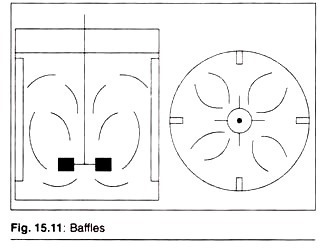In this article we will discuss about the structure of chlamydomonas (explained with labelled diagram).
The unicellular green alga Chlamydomonas is haploid with a single nucleus, a chloroplast and several mitochondria (Fig. 9.3). It can reproduce asexually as well as sexually by fusion of gametes of opposite mating types (mt+ and mt–). The mating type is controlled by a single nuclear gene. There is a fusion of the two chloroplasts in the diploid zygote. The zygote divides meiotically to produce mt+ and mt– cells in the ratio 2:2.
In 1954 Ruth Sager isolated a mutant resistant to streptomycin (sm-2) which showed a different pattern of segregation after meiosis. When a streptomycin resistant strain is crossed with a wild type strain, the resulting progeny depends upon which mating type contributed the gene for streptomycin-resistance.
Thus when the mt+ parent carries the sm-2 allele, the progeny is almost all streptomycin-resistant instead of segregating in a 2: 2 ratio. In the reciprocal cross when mt– parent has sm-2 allele, none of the progeny show streptomycin-resistance. Such uniparental transmission of a trait is typical of extra-chromosomal inheritance.
A noteworthy feature of the above crosses is the production of a very small percentage of ‘exceptional’ zygotes which receive the sm-2 allele from the mt– parent. These zygotes indicate bi-parental transmission. There is still another class of ‘exceptional’ zygotes, though rare, which transmit extra-nuclear genes only from the mt+ parent.
A class of Chlamydomonas extra-nuclear mutants known as ‘minutes’ also show bi-parental inheritance. The ‘minutes’ are induced by treatment with acriflavin and ethidium bromide.
The photosynthesis deficient mutants which depend upon acetate for growing in light, and the temperature sensitive mutants in Chlamydomonas also exhibit uniparental inheritance. All the four haploid products of meiosis are inherited from the mt+ parent. Exceptional zygotes showing bi-parental transmission occur also in these crosses at a frequency of less than 1 per cent.
There is evidence that the inheritance of the extra-nuclear traits in Chlamydomonas is due to chloroplast genes. According to Sager uniparental transmission of chloroplast genes could be due to degradation of chloroplast DNA originating from the mt– parent in the zygote. When degradation does not occur exceptional zygotes showing bi-parental inheritance are formed.
Such zygotes produce haploid progeny heterozygous for chloroplast genes. Subsequent mitotic divisions in the haploid progeny will show segregation of alleles, the members showing one or the other parental phenotype.
When two or more chloroplast genes are considered in a cross, recombinants appear, their frequencies suggesting linkage between chloroplast genes. Sager and her colleagues have extended these studies and mapped positions of chloroplast genes.
